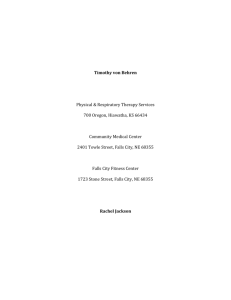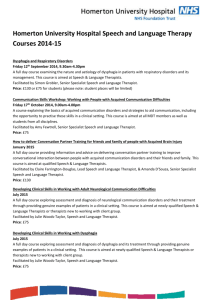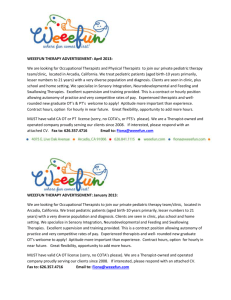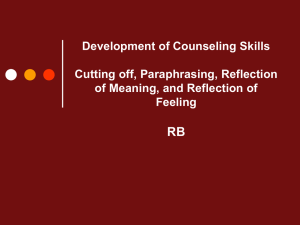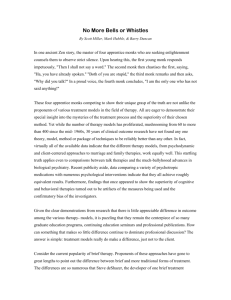We Speak Art: The Language of Community in a Cancer Center
advertisement
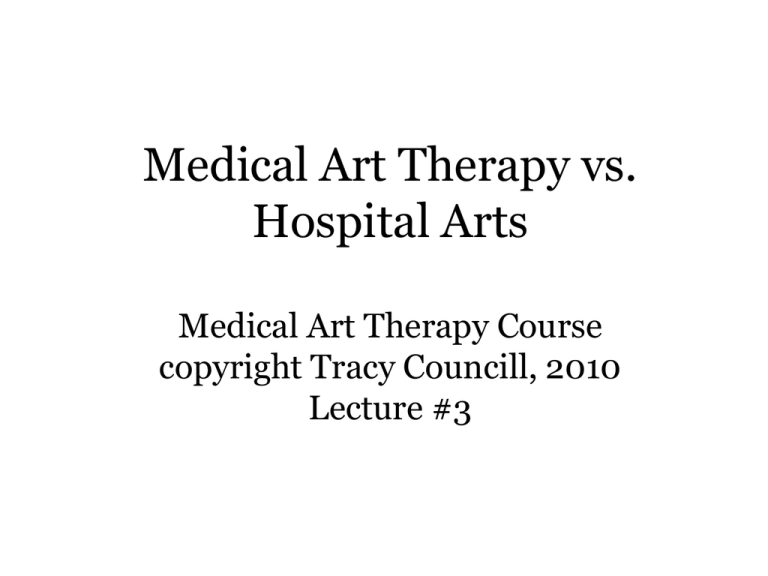
Medical Art Therapy vs. Hospital Arts Medical Art Therapy Course copyright Tracy Councill, 2010 Lecture #3 Do you see what I see? • • • Art therapists do not have a monopoly on art materials in any setting. Social workers, play therapists, counselors and other professionals often use art materials with clients. Hospital artist programs are many and varied—perhaps more common than medical art therapy programs. The Society for the Arts in Healthcare promotes many uses of the creative process in hospitals, including passive programs such as exhibits and performances, and programs that engage patients with artists at bedside or in the clinic. Drawing the distinctions between art therapists and other artists in medical settings is a difficult but critical question for our field. What distinguishes Art Therapy from other ways of using art to help people? An observer might regard this art therapy session as a kid just having fun with a caring adult. That’s part of it, but what is really going on here? The Art Therapist’s Skills Unlike most artists in hospitals, Art Therapists are trained in: • Cognitive and social development • Behavioral assessment and management • Clinical assessment, enabling them to recognize and advise the medical team when there are mental health concerns that go beyond adjustment to illness • Techniques for resolving trauma, managing anxiety, relieving pain • Therapeutic boundaries • Boundaries may be an especially important skill that the art therapist brings to the medical team. Many doctors and nurses do not receive training in this area, and they may have trouble advising patients and families and managing the psychosocial aspects of care because they may become too closely allied or remain too distant from patients and families. Invisible Structure • Much medical art therapy is done in settings that are not very private. In a clinic or infusion center, much of what is said and created at the art table is visible to everyone in the area. In a hospital room, family members, visitors, and healthcare professionals must be included, excluded or managed in some way before the therapy can begin. • Medical art therapists must work to maintain a safe environment by encouraging patients to participate, and by teaching patients, family members and healthcare providers to value open-ended creative work without judging and questioning. • Everything the art therapist says or does contributes to the safety of the art therapy space. Patience, humor, empathy, and humility give the medical art therapist the poise to teach patients, families and caregivers about art therapy—and the ability to recognize when therapeutic work is not possible at the moment. Why even try to make art therapy work in the hospital? • With so many obstacles, why try to make it work? Why not just refer patients to art therapy in the community? • Jessie James, the famous outlaw, was once asked why he robbed banks. He is said to have replied, “Because that’s where the money is.” • Art therapy in the medical setting is worth trying because that is where the patients are! A chronic illness tends to take over the life of the patient and his/her family—they spend hours and hours at the hospital, and any time they have away must be spent earning a living and caring for the everyday business of life. Most would not participate in traditional therapy, but they engage readily in a hospital-based program. Clients as Teachers • The medical environment is inherently alienating to many patients and family members. Care providers often do not realize that the language and customs of medicine are strange to patients and families. • Shirley Riley provides a helpful framework for approaching patient art: – The therapist can step into the [individual’s] drawings and let him/her teach the meaning of the visual narrative. The art is a form of personal externalization, an extension of oneself, a visible projection of thoughts or feelings. When the art is accepted, honored, and validated by the therapist, the creator is . . . equally accepted, honored and validated. . .When the problem or anxiety has been externalized . . . in a drawing, it is the perfect time to confront the problem-laden behavior and still validate the worth of the creator. (Riley, 1997, p.2) – Though medical patients may not be in the hospital to confront problem behaviors, they may find that they need help developing new strategies for managing stress and anxiety Defining Ourselves In the Tracy’s Kids Art Therapy Programs: • Art therapists serve as integrated members of the multidisciplinary treatment team. • Open studio programs in clinics and infusion centers invite open-ended creation, facilitated by trained art therapists. – Most visiting artists teach a specific skill or medium, often in a directive, product-oriented way. • Art therapists are skilled at listening for metaphoric expression in art and in recognizing content expressed in the art process itself. • Therapeutic goals are often formulated first by the art therapists, and related to patients and families through the therapeutic work itself. The Therapeutic Agreement • The Tracy’s Kids programs are designed to become part of the environment of care at the hospitals and clinics where we work. • Since we work with children, we have a Parental Permission Form, which we ask parents of all clinic kids to read and sign. The form describes the objectives and methods of our program, and allows parents to decide if they wish their children to participate. • We have never had a parent refuse permission for art therapy services. • We use the opportunity of gaining permission to educate parents about how we can help their children. Excerpt from our Permission Form How can we help? “Our Open Studio and bedside Art Therapy programs offer opportunities for kids to respond creatively to the challenges of illness and treatment. They are ‘built in’ to the clinic and hospital experience, so no appointment is necessary. Your child may wonder why he or she got sick, and have other worries about the meaning of a serious illness. Creative work with other patients and the Art Therapists can help kids work on these concerns. We can help your child cope with anxiety about medical procedures, swallowing pills, sleep problems, and adjustment after diagnosis and treatment. We also offer education and support with transitions such as returning to school, ending treatment, and going home after a long hospitalization. Feel free to call your art therapist to let her know of any specific problems your child may have. . .” Patient Art Exhibits to Educate the Hospital Community • The tension between what is public and private in the hospital community is inherent in hospital-based art therapy programs. • Respectfully exhibiting patient artwork, with appropriate permission and release, can be a very effective way to get your message out to the hospital community. • Lombardi’s annual art shows grew into group installations around a medium or theme—each individual’s expression being strengthened by the power of the art show as a whole. • For the past two years we have had group shows of work from all four Tracy’s Kids programs at a professional art gallery in downtown DC. In 2008 we launched the International Art Exchange Exhibit of work by young people in the US and the Middle East, which is presently touring the Middle East. • The following slides relate some of the issues we encountered as we began showing patient artwork in the hospital. The Problem of Artistic Quality •An art show from an art therapy program is different than a traditional art show. •In preparation for our first show, the curators of the Cancer Center’s exhibit program encouraged me to impose artistic standards on the kids’ art: a direct conflict with my commitment to include every child who wanted to participate. I was passionate about giving patients artistic control. They felt that showing a toddler’s paint scribble alongside a teenager’s realistic rendering diminished the older child’s accomplishment. We did not agree, but we stayed in conversation. Censorship: Metaphor vs. Literalism • A piece of art was removed from one exhibit because it represented a five-year old’s chemotherapy as a gun—a weapon in his fight against cancer. I fought for my young patient’s freedom of expression, but the cancer center administration removed the work. They felt any depiction of a weapon condoned violence. • Both my young patient and I found it confusing that folks at the cancer center had taught him to think of his treatment as a battle and his chemo a weapon, but they objected to the metaphor when he expressed it. Never Forget: Art is Powerful • I find that I have not always understood the meaning our patients’ art would have for others at the cancer center: • “Who We Are” was a collection of 57 life-size self-portrait sculptures. The kids represented themselves ice skating, doing karate, riding skateboards, as mermaids, explorers and sea creatures! • One of the adult oncologists was so appalled by the kids’ art that he spent an entire week trying to shut down the show! It was a reminder that art—even children’s art— can be powerful and we don’t always know the effect it will have on other people. The Children as Leaders • On the strength of the Pediatric Art Therapy Program, I began to advocate expanding art therapy to the adult patients. To try out the idea, we placed a graduate art therapy intern on the adult service. • Lombardi eventually decided to implement a broader Arts and Humanities Program in 2001, under the direction of Nancy Morgan. It is a hospital arts program, not an art therapy program, but our art therapists collaborate on projects from time to time, particularly using art to support staff development and coping. • From time to time our art therapists work with adult patients, or children of adult patients, when it is felt that the hospital artist’s capability is not sufficient. Full Circle: Art Therapy vs. Hospital Arts • Art Therapy in medicine is different from hospital arts programs. Hospital arts programs typically include exhibits, performances and a variety of art forms—music, dance, movement, writing, as well as visual art. Their goals are more general than those of a hospital art therapy program, but the two types of programs need not conflict. • The expertise of the medical art therapist opens the door to healing and support in a way that art-making by itself does not, but it is up to the art therapist to define her distinctive role and advocate for the effectiveness of her work.


